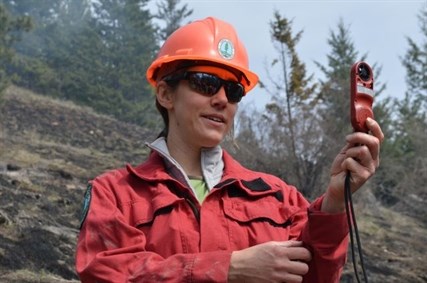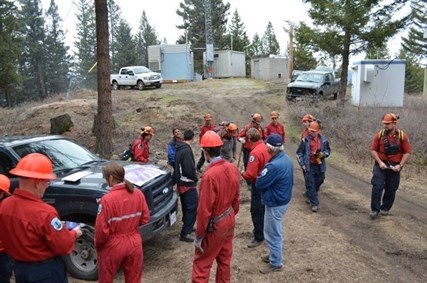
Keith Boyes of the Okanagan Shuswap Natural Resource District sets fire to the unique grassland. Ecosystems like it cover less than 1 per cent of B.C.
(CHARLOTTE HELSTON / iNFOnews.ca)
April 19, 2013 - 10:56 AM
The top 36 hectares of Satellite Hill, just south of Lumby, are tangled with fallen branches, dead brush, and heaps of pine needles a metre deep in some places. Once, the area was an open grassland home to a variety of unique plants and animals.
Under natural circumstances, the landscape would be thinned by fire every 30-50 years. The flames would reinvigorate the ecosystem, clear out debris, and keep coniferous seedlings from encroaching on the grasslands.
But fire has been forbidden here for many years, leaving the landscape homogenous and lacking biodiversity.
"The grassland ecosystem is in a very dire situation in North America," ecosystem biologist Brian Robertson says. "There are only small patches left."
Grasslands cover less than one percent of B.C. and are declining every year as trees encroach upon them. All lifeforms that depend on the unique characteristics of the ecosystem hang in the balance.
"The province has taken a position of fighting fires, and we're awfully good at putting them out," Robertson says. "But then we start losing ecosystems that aren't very abundant to begin with."
The philosophy on fire is slowly changing. It's becoming less an enemy, and more a partner, which is how a group of people from the Ministry of Forests came to be standing on Satellite Hill with drip-torches in their hands.
"We're reintroducing fire to landscapes that would naturally have been burned every few decades," Heather Rice, with the Okanagan Shuswap Natural Resource District says. "We've been controlling and putting out fires for a hundred years. It's a touchy subject. When the public sees fire, they immediately think it's a bad thing."
The Satellite Hill burn area consists of around 30 hectares of steep mountainside. In aerial photographs, the site appears as a massive bald patch on thickly forested wilderness. Comparing photographs of the site through history, you can see a gradual darkening of the image as the formerly open grassland becomes flecked with ingrowth.
The terrain is made up of dry, dusty earth, loose rocks, and patchy grasses. Ponderosa pine and Interior Douglas fir scatter the area which is spring range for mule deer and other ungulates. Vets—veteran trees some hundred years old—overlook the valley, and are protected during burns, because they provide nesting nooks for birds. Robertson says white tail deer, weasels, badgers, owls and hawks all call the area home. But as their habitat degrades, they are forced to seek resources further down the mountain and into the valley.
The prescribed burn has multiple objectives. Maintaining the grassland is one. Torching the litter layer is another. The more fuel there is lying around in the forest, the more risk there is of a wildfire getting out of control. Rice says without proper management, forests are vulnerable to intense fires, and that's of concern to people living nearby. Rice says you really can fight fire with fire.
"Even if there's some impact of smoke on the public (with a prescribed burn), it's nothing compared to what a wildfire would be like," Rice says.
Robertson says the province has been trigger happy when it comes to putting out fires, which has resulted in a build-up of debris in forests everywhere.
"Crown grassland like this is very valuable because we can manage it. A lot of it is owned privately, and we have no control over that. We can advise people to reduce stocking (by clearing out debris)."
But few people want to light fires in their backyard.
It's a destructive cycle: we put out fires only to have worse ones down the road. In the process, ecosystems start to vanish.
"Fires are natural. There are plants like Ceanothus, a great browse species, which should be all over here," Robertson says, gesturing at the steep slope the group is standing on. "Their seeds don't open up unless there's a fire, which there hasn't been here in, I'd guess a very long time."
Today, the team is looking for a low intensity burn kept close to the ground. Yesterday, they burnt what's called a blackline around the perimeter of the zone. The charred border provides a buffer in which there isn't any fuel. This prevents the fire from spreading.
The plan is to torch strips across the work area, slowly moving down the hillside as the fire burns up the slope. Each new row of flames can only go so far before it hits a blackline and beings to smolder.
Rice says there's only a three week window each year when they can burn. It didn't look like the weather would cooperate this spring. It didn't last year. This is the first and only burn to be lit in the entire North Okanagan in the past two years. A combination of things are considered when preparing for one. Venting (how well smoke will disperse), wind, temperature and precipitation all factor into the decision. On a day like today, the fire will move at around 2-4 meters per minute.
Another consideration is the existing plant make-up. Robertson says invasives are "really messing things up." Many invasive species thrive on fire, and efforts at reviving native plants with a burn can often be misguided.
Robertson also wonders how grasslands will be affected by climate change in the years ahead. "It's an interesting dilemma, climate change. Grasslands exist in dry, hot climates. If we get warmer weather, we might lose soil moisture, and those conifers might not be able to establish in the grasslands. Will grasslands expand naturally? We just don't know. Right now, we're seeing encroachment (by other species) so we burn it."
It's a around noon when the crew gets the go ahead from the Wildfire Management guys, who are there to keep things extra safe. One by one, drip-torches are drawn across the slope, leaving a fiery blaze behind them. The grass and brush spark up instantly, and a few dead trees begin to candle—spontaneously combust. Pale blue smoke blots out the sun and makes it difficult to see the spread out team. It's hard to believe, but in a few weeks, this blackened landscape will be flushing with green growth.
Amidst the crackle of the fire, the team call out to one another, warning of danger trees and tumbling rocks. The burn boss, Derek Williams shouts instructions on the spacing of the fire lines. If the fire gets too strong, the lines will be lit closer together to keep it from building in strength. If the wind dies down or it starts to drizzle, the lines will be spread apart, letting the fire gain intensity.
In an ecosystem that hasn't seen fire in a century, magical things are happening. Growth is being stimulated on "decadent" trees and shrubs that have grown old and brittle. Choked out grasses are finally getting a chance to breathe. Somewhere, a Ceanothus seed is being released.
To contact the reporter for this story, email Charlotte Helston at chelston@infotelnews.ca or call (250)309-5230.

(CHARLOTTE HELSTON / iNFOnews.ca)

Katherine Ladyman of the Okanagan Shuswap Natural Resource District uses an instrument to check wind speed, relative humidity and temperature before the burn begins.
(CHARLOTTE HELSTON / iNFOnews.ca)

"These ecosystems are so dependent on fire," Dennis Kelley, with the district, says. "There are so many species that should be here, that aren't."
(CHARLOTTE HELSTON / iNFOnews.ca)

"Fire likes to go up, so we burn down the hill," Katherine Ladyman says. "If you started at the bottom and just let it go, you could get a very out of control fire."
(CHARLOTTE HELSTON / iNFOnews.ca)

The crew musters at the top of Satellite Hill, located 6 kilometres south of Lumby, up a maze of logging roads in the Harris Creek area.
(CHARLOTTE HELSTON / iNFOnews.ca)
News from © iNFOnews, 2013